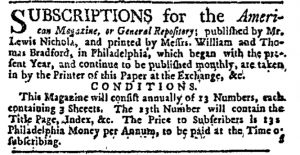What was advertised in a colonial American newspaper 250 years ago today?

“Subscriptions for the American Magazine, published in Philadelphia.”
On behalf of Lewis Nicola, the editor of the American Magazine, John Carter inserted a brief advertisement in the July 8, 1769, edition of the Providence Gazette. In just four lines, it advised readers in Rhode Island that “Subscriptions for the American Magazine, published in Philadelphia by the Editor Lewis Nicola, are received by the Printer hereof, at 13 s. Pennsylvania Currency per Annum, to be paid on subscribing.” This notice was much less extensive than some that appeared in other newspapers. An advertisement that ran in the New-York Journal almost two months earlier informed prospective subscribers of the length of each issue and promised a title page and index with the final edition for the year. Another much more extensive advertisement appeared in Richard Draper’s Massachusetts Gazette at the end of May. It described magazines as “the Taste of the Age” and provided an overview of the publication’s purpose and contents. The editor aimed “To instruct, and innocently amuse” readers. The magazine served as “a Repository for the many small, tho’ valuable Pieces that would otherwise be lost to the World.”
Though vastly different in length and content, these advertisements provide an example of the networks that members of the book trades established in eighteenth-century America. Realizing that local markets alone would not sustain some of their enterprises, printers and publishers banded together, sometimes formally but often informally, to assist each other. This included exchanging newspapers and then liberally reprinting content from one to another, but disseminating information was not the extent of the work accomplished by these networks. Note that Carter, the printer of the Providence Gazette, served as a local agent for Nicola in Providence, as did Draper, the printer of the Massachusetts Gazette, in Boston, and John Holt, the printer of the New-York Journal, in New York. These printers did not merely publish Nicola’s advertisement; they also informed him of the subscribers in their cities, collected subscription fees, and likely aided in the distribution of the American Magazine.
Publishing books, magazines, and other printed materials in eighteenth-century America often depended on these networks of cooperation among members of the book trades, especially printers and publishers. Sometimes such networks played a significant role in the success of an endeavor; other times, they were not enough to overcome other factors that ultimately led to the failure of publications. Nicola’s American Magazine ceased publication within three months of the advertisement in the Providence Gazette. Yet his efforts provided an important marketing model that other magazine publishers successfully deployed after the American Revolution.


